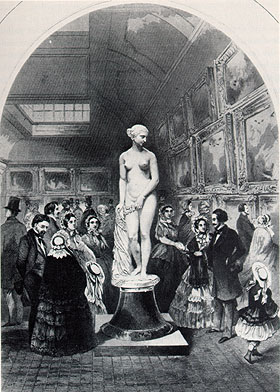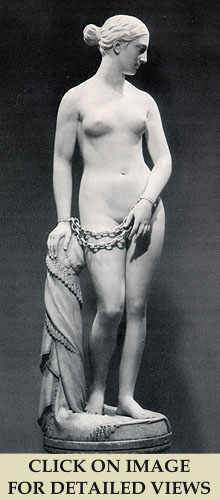

This sculpture by Hiram Powers was perhaps the most popular American work of art at mid-century. Over one hundred thousand people paid to see it during its 1847-1848 tour around the country. Powers himself supplied this gloss on the statue's sensational subject--a woman on sale as a sexual object:
"The Slave has been taken from one of the Greek Islands by the Turks, in the time of the Greek Revolution; the history of which is familiar to all. Her father and mother, and perhaps all her kindred, have been destroyed by her foes, and she alone preserved as a treasure too valuable to be thrown away. She is now among barbarian strangers, under the pressure of a full recollection of the calamitous events which have brought her to her present state; and she stands exposed to the gaze of the people she abhors, and awaits her fate with intense anxiety, tempered indeed by the support of her reliance upon the goodness of God. Gather all these afflictions together, and add to them the fortitude and resignation of a Christian, and no room will be left for shame."
Powers' friend Miner Kellogg, who managed the tour, in 1848 put together a pamphlet for the exhibition that included excerpts from some of the pieces below. There Kellogg also supplied viewers with this further cue about how to "read" the statue:
"The ostensible subject is merely a Grecian maiden, made captive by the Turks and exposed at Constantinople, for sale. The cross and locket, visible amid the drapery, indicate that she is a Christian, and beloved. But this simple phase by no means completes the meaning of the statue. It represents a being superior to suffering, and raised above degradation, by inward purity and force of character. Thus the Greek Slave is an emblem of the trial to which all humanity is subject, and may be regarded as a type of resignation, uncompromising virtue, or sublime patience."
With more or less irony, four of the pieces below — the letter to Frederick Douglass' anti-slavery paper The North Star, the two articles from the abolitionist National Era, the Washington weekly in which Uncle Tom's Cabin first appeared, and the poem from The Independent, a New York religious weekly with a strong anti-slavery stance — connect Powers' Greek slave to the millions of enslaved persons in the United States. On the whole, however, American responses to the statue are silent about any relationship between Greek slaves and American slavery, even when it was exhibited in Southern cities like New Orleans. As the poet in The Independent notes, the American government even chose to use Powers' work as the centerpiece of the nation's exhibit at the 1851 World's Fair in the Crystal Palace in London.
 |
|
